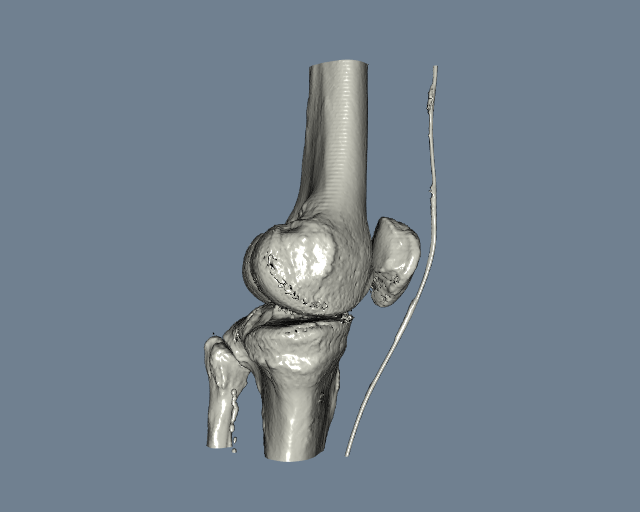ReadSLC
Repository source: ReadSLC
Description¶
In this example you will familiarize yourself with the stages required to read a .slc file and create a visualization pipeline in VTK. Following is the three-step procedure:
-
Read the data from .slc file using vtkSLCReader
-
Implement Marching cubes Algorithm using vtkContourFilter
-
Create Visualization pipeline to visualize data using an actor, mapper and rendering window
Cite
This example was provided by Bharatesh Chakravarthi from Virtual Environment Lab, Chung-Ang University, Seoul, South Korea
Other languages
See (Cxx), (PythonicAPI), (Java)
Question
If you have a question about this example, please use the VTK Discourse Forum
Code¶
ReadSLC.py
#!/usr/bin/env python
# noinspection PyUnresolvedReferences
import vtkmodules.vtkInteractionStyle
# noinspection PyUnresolvedReferences
import vtkmodules.vtkRenderingOpenGL2
from vtkmodules.vtkCommonColor import vtkNamedColors
from vtkmodules.vtkFiltersCore import vtkContourFilter
from vtkmodules.vtkFiltersModeling import vtkOutlineFilter
from vtkmodules.vtkIOImage import vtkSLCReader
from vtkmodules.vtkRenderingCore import (
vtkActor,
vtkPolyDataMapper,
vtkRenderWindow,
vtkRenderWindowInteractor,
vtkRenderer
)
def main():
InputFilename, iso_value = get_program_parameters()
colors = vtkNamedColors()
# vtkSLCReader to read.
reader = vtkSLCReader()
reader.SetFileName(InputFilename)
reader.Update()
# Create a mapper.
mapper = vtkPolyDataMapper()
mapper.SetInputConnection(reader.GetOutputPort())
# Implementing Marching Cubes Algorithm to create the surface using vtkContourFilter object.
contourFilter = vtkContourFilter()
contourFilter.SetInputConnection(reader.GetOutputPort())
# Change the range(2nd and 3rd Parameter) based on your
# requirement. recommended value for 1st parameter is above 1
# contourFilter.GenerateValues(5, 80.0, 100.0)
contourFilter.SetValue(0, iso_value)
outliner = vtkOutlineFilter()
outliner.SetInputConnection(reader.GetOutputPort())
outliner.Update()
mapper = vtkPolyDataMapper()
mapper.SetInputConnection(contourFilter.GetOutputPort())
mapper.SetScalarVisibility(0)
actor = vtkActor()
actor.SetMapper(mapper)
actor.GetProperty().SetDiffuse(0.8)
actor.GetProperty().SetDiffuseColor(colors.GetColor3d('Ivory'))
actor.GetProperty().SetSpecular(0.8)
actor.GetProperty().SetSpecularPower(120.0)
# Create a rendering window and renderer.
renderer = vtkRenderer()
renderWindow = vtkRenderWindow()
renderWindow.AddRenderer(renderer)
renderWindow.SetSize(500, 500)
# Create a renderwindowinteractor.
renderWindowInteractor = vtkRenderWindowInteractor()
renderWindowInteractor.SetRenderWindow(renderWindow)
# Assign actor to the renderer.
renderer.AddActor(actor)
renderer.SetBackground(colors.GetColor3d('SlateGray'))
# Pick a good view
cam1 = renderer.GetActiveCamera()
cam1.SetFocalPoint(0.0, 0.0, 0.0)
cam1.SetPosition(0.0, -1.0, 0.0)
cam1.SetViewUp(0.0, 0.0, -1.0)
cam1.Azimuth(-90.0)
renderer.ResetCamera()
renderer.ResetCameraClippingRange()
renderWindow.SetWindowName('ReadSLC')
renderWindow.SetSize(640, 512)
renderWindow.Render()
# Enable user interface interactor.
renderWindowInteractor.Initialize()
renderWindow.Render()
renderWindowInteractor.Start()
def get_program_parameters():
import argparse
description = 'Read a .slc file.'
epilogue = ''''''
parser = argparse.ArgumentParser(description=description, epilog=epilogue,
formatter_class=argparse.RawDescriptionHelpFormatter)
parser.add_argument('filename', help='vw_knee.slc.')
parser.add_argument('iso_value', nargs='?', type=float, default=72.0, help='Defaullt 72.')
args = parser.parse_args()
return args.filename, args.iso_value
if __name__ == '__main__':
main()
